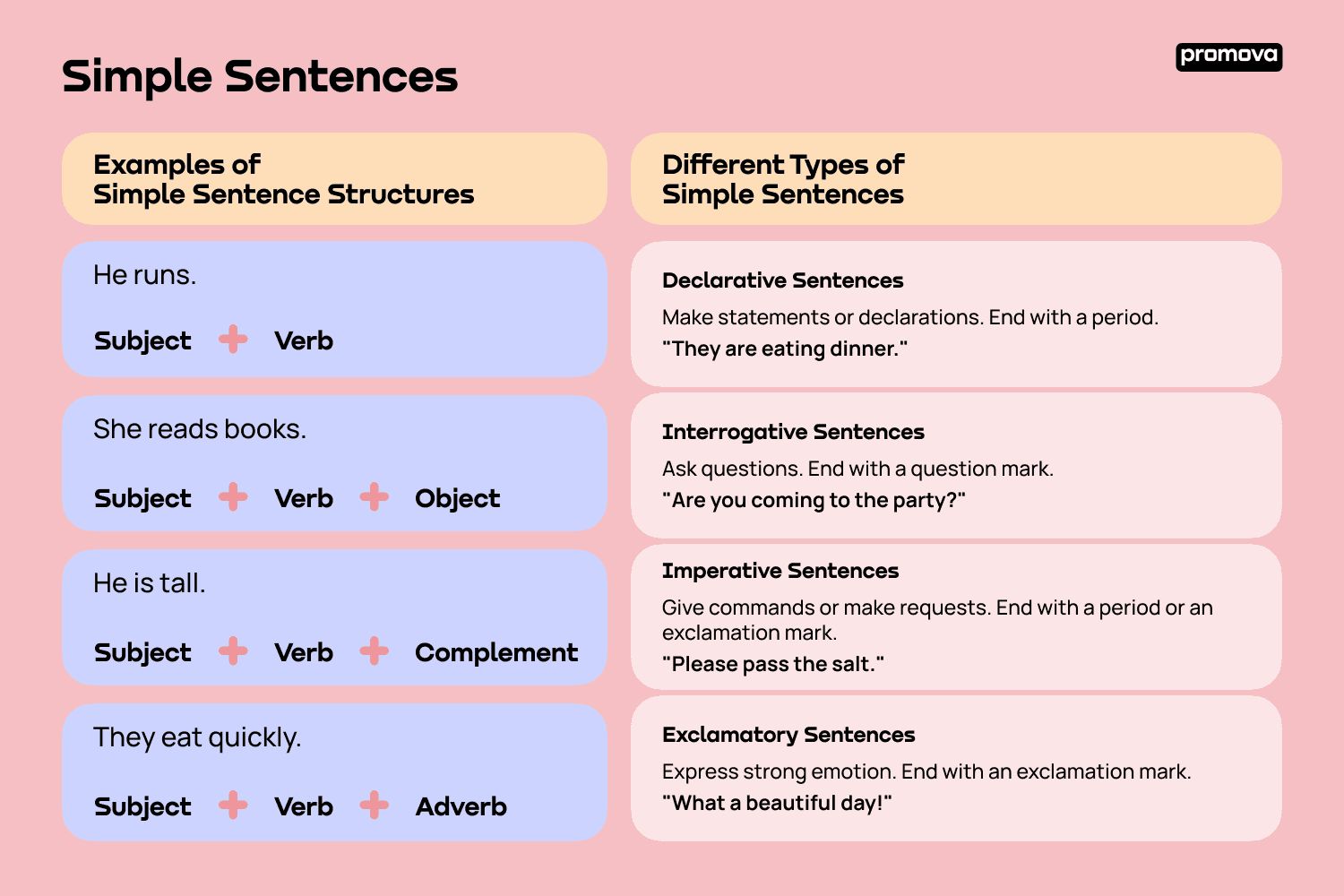Simple Sentences
Contents
If you're just starting to learn English, you may have heard about sentence types. But what exactly is a simple sentence and how is it different from others? In this reference, we'll go over the definition of a simple sentence, different types of simple sentences, how to identify them, and common mistakes to avoid. Let's dive in!
What is a Simple Sentence?
A simple sentence has only a single independent clause. Independent clauses are groups of words which contain a subject and a predicate - they express a complete thought. In other words, a simple sentence is a sentence that has one subject and one verb and expresses a complete idea.
Here's an example of a simple sentence: "She sings." This sentence contains one subject ("she") and one verb ("sings") and expresses a complete thought. It's important to note that a simple sentence can be longer than one word, but it must still only contain one independent clause.

Examples of Simple Sentence Structures
There are many ways to make a simple sentence. Here are a few examples:
- Subject + Verb: "He runs."
- Subject + Verb + Object: "She reads books."
- Subject + Verb + Complement: "He is tall."
- Subject + Verb + Adverb: "They eat quickly."
As you can see, the structure of a simple sentence can vary, but it must always contain one subject and one predicate.
Different Types of Simple Sentences
There are four types of simple sentences: declarative, interrogative, imperative, and exclamatory.
Declarative Sentences
Declarative sentences make statements or declarations. They end with a period.
Example: "They are eating dinner."
Interrogative Sentences
Interrogative sentences ask questions. They end with a question mark.
Example: "Are you coming to the party?"
Imperative Sentences
Imperative sentences give commands or make requests. They can end with a period or an exclamation mark.
Example: "Please pass the salt."
Exclamatory Sentences
Exclamatory sentences express strong emotion. They end with an exclamation mark.
Example: "What a beautiful day!"
How to Identify Simple Sentences in English
Identifying simple sentences in English is fairly straightforward. Look for sentences that contain one subject and one predicate and express a complete thought. Here are a few examples:
- "I love pizza."
- "She dances well."
- "They play soccer every Saturday."
Each of these sentences contains one subject and one predicate and expresses a complete thought. Therefore, they are all examples of simple sentences.
1
Subject and Predicate
As we mentioned earlier, a simple sentence consists of one subject and one predicate. The subject is the person, idea, place, or thing that your sentence is about. The predicate is the action or state of being that the subject is performing or experiencing.
For example: "The dog barked." In this sentence, "The dog" is our subject and "barked" is the predicate. The subject informs us what the sentence is about, and the predicate tells us what the subject is doing.
Common Mistakes
When it comes to simple sentences, there are a few common mistakes that English learners often make. Here are a few to watch out for:
Run-On Sentences
A run-on sentence contains two or more clauses that are not properly connected. This can make the sentence confusing and difficult to read. To fix a run-on sentence, you can either separate the clauses into separate sentences or connect them with a conjunction.
Example of a run-on sentence: "She went to the store she bought some milk."
Fragments
A sentence fragment is a selection of words which does not form a complete sentence. It's important to remember that a sentence must contain one subject and one predicate and express a complete thought.
Example of a sentence fragment: "After school."
Missing Subjects or Predicates
Sometimes, English learners forget to include either a subject or a predicate in their sentences. This can make the sentence incomplete and confusing.
Example of a missing subject: "Runs fast." Example of a missing predicate: "The dog."
Summary
A simple sentence has only a single independent clause. It contains one subject and one predicate and expresses a complete thought. To identify simple sentences in English, look for sentences that contain one subject and one predicate and express a complete thought. Keep practicing, and soon you'll be a master of creating your own simple sentences!
Comments